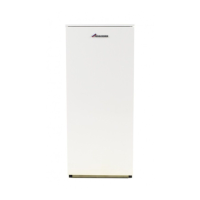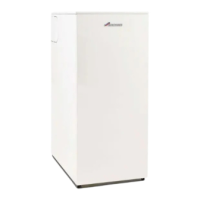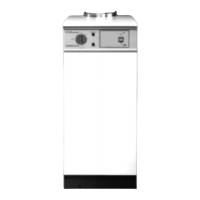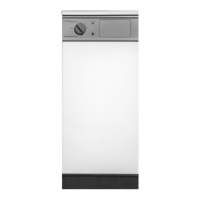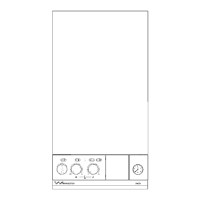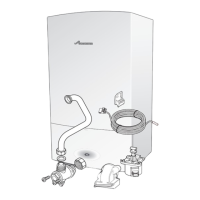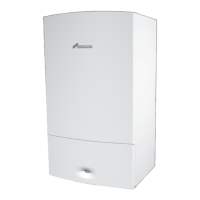4.1 The appliance is not suitable for external installation unless
a suitable enclosure is provided.
4.2 The appliance should be positioned on a non-combustible
solid base as near to the flue location point as possible. Care
should be taken to ensure that the appliance is level; use
packing at the corners where necessary.
4.3 When fitting a LLD or RS model the rear of the appliance
must be positioned against an external wall such that the flue
terminal can safely discharge the flue gases as described in
Section 7.
4.4 The following clearances must be left to allow access for
installation and servicing:
(a) Above 300mm
(b) In front - 600mm
(c) Right and left hand side – sufficient for panel removal and
access to pipe connections where required.
See Figs. 2 and 3.
For installation and servicing of the appliance the cabinet should
be removed as follows:
5.1 Remove the cabinet top panel by lifting squarely upwards to
release the four ball stud connections.
5.2 Remove the front panel by pulling the bottom of the panel
forwards to release the lower ball studs and then repeat the
procedure at the top end to release the upper ones. Take care
not to pull the bottom end too far forwards as this may cause
damage to the spring clips.
5.3 The side panels are removed by firstly following procedures
5.1to 5.2 as described above, then remove screw (A) from the side
panel base and the three screws located in the upper flange of each
side panel. Ease the panel clear of the electrical control box and
slide forwards to release from the locating lugs on the base plate.
5.4 The control box can be removed by undoing the four screws
in the front facia cover and then removing the wing nut on the
underside of the control box. The thermostat phials should be
carefully removed from the phial pockets and the control box
placed in a safe place taking care not to kink the thermostat
capillary tubes.
5.5 On the RS balanced flue model, remove the burner box cover
by pulling forwards to release the ball studs. This will be found
easier by pulling on one side of the handle first to release two of
the ball studs and then repeating on the other side. Take care
not to pivot the remaining two ball studs too far around as this
will cause damage to the spring clips.
OPEN FLUE MODEL (CF/LLD)
6.1
In order to ensure clean and efficient combustion an
adequate supply of air must be delivered to the combustion
chamber. To provide sufficient air a suitable inlet should be
provided into the room or space in which the boiler is situated,
the sizes of which are shown in Table 9. An air brick or other form
of continuous air supply may have to be built into the installation
in order to ensure an adequate supply of air.
6.2 If the appliance is to be installed in a confined space or
compartment, two air vents are required, one at high level and
one at low level. The minimum free area of each vent is given in
Table 10 and depends whether the air is taken from another
room or from outside the building. Where the air is taken from
another room that room must contain an air inlet as described in 6.1.
6.3 There must be sufficient clearance around the appliance to
allow proper circulation of ventilation air. The clearances required
for Installation and Servicing will normally be adequate for
ventilation. See Section 4.4
ROOM SEALED BALANCED FLUE MODEL (RS)
6.4 The appliance does not require a separate vent for
combustion air.
6.5 Installation in cupboards or compartments require
permanent vents for cooling purposes, one at high level and one
at low level, either direct to outside air or to a room. Both vents
must pass to the same room or be on the same wall to the
outside air. The minimum air vent free area is given in Table 11.
6.6 There must be sufficient clearance around the appliance to
allow proper circulation of ventilation air. The clearances required
for Installation and Servicing will normally be adequate for
ventilation. See Section 4.4.
5. Removal Of The Cabinet
4. Siting The Appliance
Appliance
Ventilation to room or
Ventilation to outside
model
internal space
High Level Low Level High Level Low Level
12/14 154cm
2
231cm
2
77cm
2
154cm
2
15/19 209cm
2
314cm
2
105cm
2
209cm
2
20/25 275cm
2
413cm
2
138cm
2
275cm
2
26/32 352cm
2
528cm
2
176cm
2
352cm
2
32/50 550cm
2
825cm
2
275cm
2
550cm
2
50/70 770cm
2
1155cm
2
385cm
2
770cm
2
6
AREA OF AIR INLET
cm
2
in.
2
12/14 77 12
15/19 105 16.5
20/25 138 21.5
26/32 176 27.5
32/50 275 43
50/70 385 60
Table 9. Minimum Combustion Air Inlet Free Area for
Open Flue appliances.
Table 10. Minimum Air Vent Free Area for Open Flue
appliances installed in a compartment.
Table 11. Minimum Air Vent Free Area for Room Sealed
appliances installed in a compartment.
Appliance
Ventilation to room or
Ventilation to outside
model
internal space
High Level Low Level High Level Low Level
12/14 154cm
2
154cm
2
77cm
2
77cm
2
15/19 209cm
2
209cm
2
105cm
2
105cm
2
20/25 275cm
2
275cm
2
138cm
2
138cm
2
26/32 352cm
2
352cm
2
176cm
2
176cm
2
6. Air Supply
Appliance
model
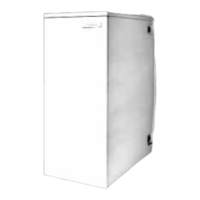
